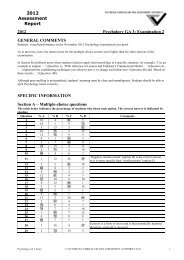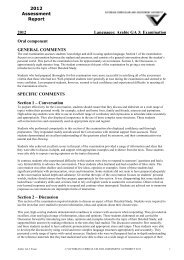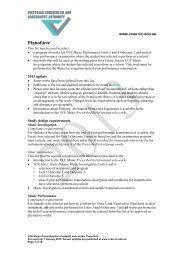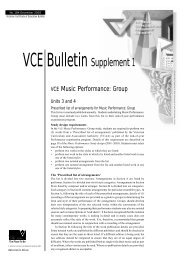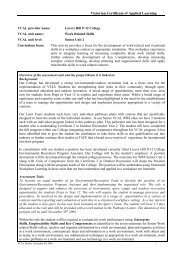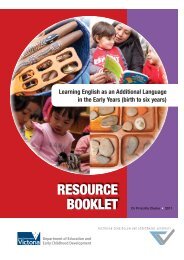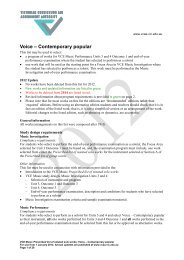television, digital media and children's learning - Victorian ...
television, digital media and children's learning - Victorian ...
television, digital media and children's learning - Victorian ...
You also want an ePaper? Increase the reach of your titles
YUMPU automatically turns print PDFs into web optimized ePapers that Google loves.
Whether or not parents can see the potential <strong>learning</strong> value of <strong>media</strong> exposure, <strong>and</strong> what is<br />
called the <strong>digital</strong> divide are the main barriers to children’s <strong>media</strong> use, apart from <strong>television</strong><br />
which is universal.<br />
Technology puts a lot of pressure on today’s families. It is costly to be connected, to have<br />
mobile phones, cable access <strong>and</strong> the latest iPod. The <strong>digital</strong> divide is exacerbating<br />
inequalities in access to good schooling <strong>and</strong> other children’s services. Many parents are<br />
pulled in two ways by the new technology – they fear its negative impacts: passivity, physical<br />
inactivity, pornography <strong>and</strong> cyber-bullying. But they sense that without adequate exposure<br />
<strong>and</strong> skill acquisition their children will be disadvantaged.<br />
This is the modern version of educational inequality, which has always reflected both parental<br />
income <strong>and</strong> their perceptions of the value of education. The most recent OECD comparisons<br />
suggest that the education divide is reopening, with 7.2% of children having fewer than 11<br />
books in the home, 12% of children living in households where income is less than half the<br />
national <strong>media</strong>n, <strong>and</strong> psychological problems rising. Income influences what products families<br />
can buy, including access to cable TV <strong>and</strong> the internet.<br />
In the United States,<br />
“The growing importance of the internet has created a new disparity across class lines<br />
in children’s access to skills, social networks <strong>and</strong> intellectual resources. While children<br />
with high household incomes enjoy speedy, pervasive access to technology at home<br />
<strong>and</strong> at school (either private or affluent public school districts), others struggle to<br />
compete for intermittent access to slow machines that are outdated <strong>and</strong> erratic….<br />
Those young children without access to the internet … are considered to be seriously<br />
disadvantaged, cut off from opportunities, unskilled for future work, <strong>and</strong> disconnected<br />
from peers.” (Montgomery, 2007, p. 210)<br />
There are no Australian studies that break down children’s <strong>media</strong> usage by race or ethnicity,<br />
but the LSAC data on four-year-olds described above suggest that parental education levels,<br />
family income <strong>and</strong> other factors such as working hours, father absence <strong>and</strong> number of siblings<br />
do have an impact on their viewing patterns <strong>and</strong> developmental outcomes. As Professor Alan<br />
Hayes puts it, ‘While social class differences are not evident in early infancy, by six or seven<br />
years of age, developmental outcomes are clearly differentiated by parents’ social position.’<br />
(The Australian, 21 October, 2008)<br />
With the global financial crisis impacting on Australia, that income gap may well become wider<br />
<strong>and</strong> public institutions such as children’s <strong>and</strong> family support services, child care centres <strong>and</strong><br />
pre-schools, local libraries <strong>and</strong> schools will have to become key providers of access to<br />
computers, specialist games, <strong>and</strong> <strong>media</strong> literacy programs.<br />
Australia is a rapid adopter of any new technology, but there remains a significant <strong>digital</strong><br />
divide which the government is currently trying to address. The number of dwellings with<br />
access to the internet increased from 35% in 2001 to 63% by the 2006 Census. (ABS, 2006)<br />
Nationally, access varies from 66% of households in the major cities to 42% in very remote<br />
areas (with just 28% of these remote households on Broadb<strong>and</strong>). The ACT is highest (75%),<br />
with South Australia, Tasmania <strong>and</strong> the Northern Territory lowest (between 28-32%). As well,<br />
the top quintile of household incomes has 77% with access compared with only 34% for the<br />
lowest quintile household group. Those with post-graduate education are 83% more likely to<br />
have access to the internet than those with no post-school qualifications. The unmarried, lowskilled,<br />
indigenous <strong>and</strong> unemployed also have lower access.<br />
An Australian study by the Smith Family found a new <strong>digital</strong> divide between those who are<br />
part of ‘the new participatory creative culture’ <strong>and</strong> those who are not. That is, inequality is not<br />
22




